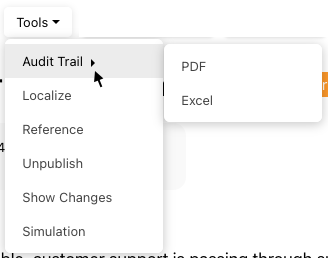An audit trail is a chronological record that offers documentary evidence of the sequence of activities that have impacted any EPC object at various points in time. It focuses on tracking who performed what actions, when they did so, where these actions occurred, and how they were executed. The EPC diligently records all modifications made to objects, allowing users to retrieve audit trails in the form of either an Excel spreadsheet or a PDF document.
Downloading an Audit Trail
It is now possible to download audit trails for any object within EPC, providing a comprehensive history of activities. To retrieve an audit trail, follow these steps:
- Navigate to the Details view of the object for which you require the audit trail.
- In the “Tools” section, click on “Audit Trail”.
- Select your preferred format, either an Excel spreadsheet or a PDF document.
- Once you’ve made your selection, an .xls or PDF file will be downloaded to your computer, providing a detailed record of the object’s audit trail. Please note that downloading an audit trail can take a few moments.
Audit Trail Content
In the audit trail document, you’ll find the name, current version and system serial number (SSN) of the object. The audit trail provides the following key information:
| Name | Description |
|---|---|
| Object Name | The name of the object that was modified |
| Object Type | The type of the object that was modified |
| Version | The version number of the object at the time of modification |
| Last Modified By | The user responsible for the modification |
| Date | The date of the modification |
| Type of Change | The type of modification made to the object |
| Field | The field which was modified |
| Language | The editing language at the time of modification |
| Action | The specific modification made by the user |
| Old Value | The existing value prior to the modification |
| New Value | The modified value |
| Target Type | The target of any associations created or modified |
Need more help with this?
Visit the Support Portal



